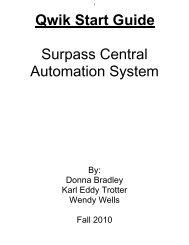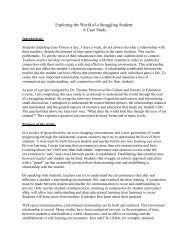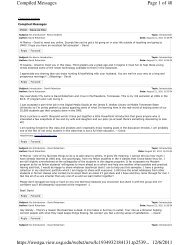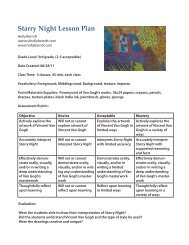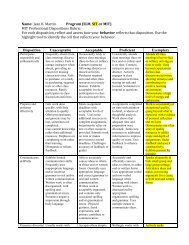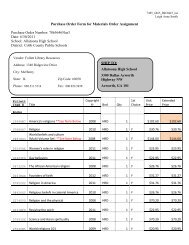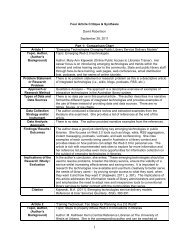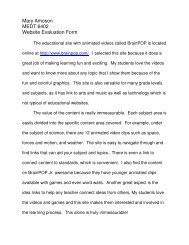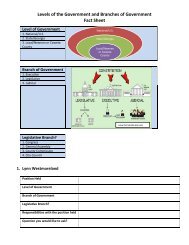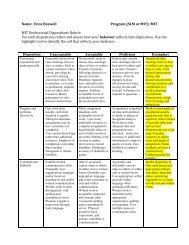Research Article Review Chart Reference Purpose Research ...
Research Article Review Chart Reference Purpose Research ...
Research Article Review Chart Reference Purpose Research ...
Create successful ePaper yourself
Turn your PDF publications into a flip-book with our unique Google optimized e-Paper software.
<strong>Research</strong> <strong>Article</strong> <strong>Review</strong> <strong>Chart</strong><br />
<strong>Reference</strong> <strong>Purpose</strong> <strong>Research</strong><br />
Questions<br />
Karcher-Klien, R.<br />
Reexamining the<br />
Practicum Placement:<br />
How to Leverage<br />
Technology to Prepare<br />
Pre-service Teachers<br />
for the Demands of the<br />
21 st Century. Journal<br />
of Computing in<br />
Teacher Education,<br />
(23)4, 121-129.<br />
Retrieved from ERIC<br />
Database<br />
Shoffner, Melanie.<br />
Personal Attitudes and<br />
Technology:<br />
Implications for<br />
Preservice Teacher<br />
Reflective Practice.<br />
Teacher Education<br />
Quarterly, Spring<br />
Provide preservice<br />
teachers<br />
with an<br />
opportunity to<br />
work with<br />
experienced<br />
teachers and to<br />
interact with<br />
school children<br />
to develop<br />
technology<br />
based lessons<br />
that can be<br />
integrated into<br />
the classroom.<br />
Examine the<br />
attitudes of preservice<br />
teachers<br />
toward the use<br />
of weblogs and<br />
how their<br />
attitude towards<br />
technology<br />
How does a<br />
virtual practicum<br />
create<br />
opportunities to<br />
learn ways to<br />
manage<br />
technology<br />
integration in the<br />
classroom<br />
How does a<br />
virtual practicum<br />
create<br />
opportunities to<br />
learn ways to<br />
integrate<br />
technology into<br />
literacy<br />
instruction<br />
How does a<br />
shared practicum<br />
experience allow<br />
preservice<br />
teachers to<br />
engagte in class<br />
discussions and<br />
problem-solve<br />
issues confronted<br />
in their host<br />
classrooms<br />
How does a<br />
students’<br />
individual<br />
attitude toward<br />
technology effect<br />
their use of<br />
weblogs<br />
Participants Methods Data Analysis Limitations/<br />
Reliability/<br />
Validity<br />
2 classroom<br />
teachers, 1 st and 4 th<br />
grade students, and<br />
30 student teachers<br />
-4 African<br />
American<br />
-26 Caucasian<br />
-29 women<br />
-1 male<br />
-Ages 23-55<br />
9 pre-service<br />
teachers<br />
--5 females<br />
--4 males<br />
--early to 20s<br />
E-mail<br />
correspondences<br />
--pre-service<br />
teachers and<br />
elementary<br />
students<br />
--instructor and<br />
classroom<br />
teachers<br />
--pre-service<br />
teachers and<br />
classroom<br />
teachers<br />
Field notes of<br />
class discussions<br />
Survey for preservice<br />
teachers<br />
8 month study<br />
within a 12 month<br />
teacher education<br />
program<br />
--participants<br />
were required to<br />
maintain a weblog<br />
Information was coded<br />
into 7 categories<br />
--future technology<br />
integration<br />
--differences in virtual<br />
and traditional<br />
practicum<br />
--hands-on experience<br />
--awareness<br />
--management<br />
--innovative ideas<br />
--communication<br />
Survey<br />
--8 Likert Scale<br />
questions<br />
--students were asked to<br />
rate the topics/explain<br />
their ratings<br />
--6 open ended<br />
questions<br />
--based on the<br />
differences between<br />
virtual practicum and a<br />
traditional practicum<br />
The study was based on<br />
content analysis—<br />
repeating elements and<br />
recurring themes during<br />
the study were noted<br />
and categorized.<br />
coding<br />
None reported in<br />
the article<br />
None were<br />
reported<br />
Results/<br />
Findings<br />
<strong>Research</strong> Question 1:<br />
The pre-service teachers had to<br />
manage 3 tasks—email<br />
correspondence, technology related<br />
projects, and internet safety<br />
--83% of the pre-service teachers<br />
were motivated to integrate<br />
technology into their own<br />
instruction<br />
<strong>Research</strong> Question 2:<br />
--Use of the internet/ virtual<br />
practicum web page to correspond<br />
--Use of email for pre-service<br />
teachers and elementary students to<br />
correspond<br />
--Projects required students to use<br />
various forms of technology to<br />
develop responses<br />
--100% agreed/strongly agreed that<br />
the project was a good example of<br />
how to integrate the internet<br />
<strong>Research</strong> Question 3:<br />
--Creates an environment where<br />
pre-service students feel safe<br />
discussing issues<br />
Found that attitude toward<br />
technology had “very little” impact<br />
on the use of weblogs<br />
Of the 9 pre-service teachers:<br />
--8 expressed a positive attitude<br />
toward the use of technology<br />
--5 maintained a weblog both fall<br />
Implications<br />
The article concludes<br />
that more research is<br />
necessary in order to<br />
find ways to prepare<br />
new teachers to<br />
integrate technology.<br />
None were reported
2009, 143-161.<br />
Retrieved from ERIC<br />
Database<br />
U.S. Department of<br />
Education. (2010)<br />
Educational<br />
Technology in U.S.<br />
Public Schools: Fall<br />
2008. Retrieved from<br />
ERIC Database.<br />
influences their<br />
use of<br />
technology for<br />
voluntary<br />
reflection.<br />
Report the<br />
availability of<br />
technology in<br />
public<br />
elementary and<br />
secondary<br />
schools.<br />
What are the<br />
implications of<br />
pre-service<br />
teacher attitudes<br />
toward<br />
technology for<br />
teacher<br />
educators<br />
None were<br />
presented.<br />
<strong>Research</strong> is<br />
based on<br />
information<br />
received from<br />
about the<br />
technology that<br />
is available.<br />
1519 schools<br />
returned<br />
questionnaire<br />
for the duration of<br />
the study<br />
Data was<br />
collected: Fall<br />
2004; Spring<br />
2005; Summer<br />
2005<br />
Study consisted<br />
of:<br />
--263 weblog<br />
entries<br />
--2 focus group<br />
interviews<br />
--23 individual<br />
interviews<br />
Survey<br />
Responses are weighted<br />
in order to produce<br />
national estimates based<br />
on the survey sample.<br />
Standard of error is<br />
calculated to measure<br />
precision from the<br />
sample.<br />
Estimates from the<br />
data are subject to<br />
error because the<br />
data is collected<br />
from a sample.<br />
and spring semesters<br />
--only 2 maintained a weblog the<br />
entire length of the study<br />
However, at the end of the study,<br />
they each expressed a positive view<br />
of weblogs.<br />
100% of public schools have one or<br />
more instructional computers<br />
97% had one or more instructional<br />
computers located in classrooms<br />
58% laptops on carts<br />
Of the computers in schools—<br />
91% used for instructional purposes<br />
None reported<br />
97% technology devices for<br />
instruction<br />
73% interactive whiteboards<br />
Sugar, William &<br />
Wilson, Kenneth.<br />
Seeking Alternatives<br />
to Inservice<br />
Technology<br />
Workshops from<br />
Teachers’<br />
Perspectives. Journal<br />
of Computing in<br />
Teacher Education,<br />
(21)4, 91-98.<br />
Determine<br />
possible<br />
alternatives to<br />
in-service<br />
technology<br />
workshops<br />
based on<br />
teachers’<br />
perspectives<br />
What are the best<br />
approaches on<br />
how to learn a<br />
new technology<br />
What<br />
improvements<br />
can be made to<br />
existing<br />
technology inservice<br />
The initial<br />
questionnaire was<br />
developed by 6<br />
middle school<br />
teachers; 2<br />
administrators—1<br />
principal and 1 tech<br />
lab coordinator.<br />
Initial survey:<br />
497 were<br />
completed<br />
Preliminary<br />
interviews<br />
Initial survey<br />
Final survey<br />
Likert Scale questions<br />
were used for the<br />
survey<br />
None were<br />
reported<br />
31% full time staff responsible for<br />
technology support and technology<br />
integration<br />
Majority of the teachers that<br />
completed the survey prefer handson<br />
in-service workshops<br />
Respondents reported that in-service<br />
workshops were beneficial to<br />
learning how to use new<br />
technologies.<br />
Author notes that<br />
47.2% of the<br />
respondents rated<br />
themselves as very<br />
confident or confident<br />
when comes to using<br />
technology and 44.8%<br />
rated themselves as<br />
average.<br />
85% of these rated<br />
their own technology
Retrieved from ERIC<br />
Database.<br />
workshops<br />
What technology<br />
advice do<br />
teachers<br />
currently seek<br />
What obstacles<br />
prevent teachers<br />
from integrating<br />
technology<br />
Final survey:<br />
875 were<br />
completed<br />
skills as competent or<br />
average.<br />
More research is<br />
needed on teachers’<br />
technology skills and<br />
perceived confidence.<br />
Garthwait, Abigail &<br />
Weller, Herman G. A<br />
Year in the Life: Two<br />
Seventh Grade<br />
Teachers Implement<br />
One-to-One<br />
Computing. Journal of<br />
<strong>Research</strong> on<br />
Technology in<br />
Education, (37)4, 361-<br />
377. Retrieved form<br />
ERIC Database<br />
Means, Barbara.<br />
Technology and<br />
Education Change:<br />
Focus on Student<br />
Learning. Journal of<br />
<strong>Research</strong> on<br />
Technology in<br />
Education, (42)3, 285-<br />
307. Retrieved from<br />
ERIC Database.<br />
Analysis of the<br />
Maine Learning<br />
Technology<br />
Initiative that<br />
provided every<br />
student in an<br />
entire grade<br />
with laptop<br />
computers.<br />
Examine<br />
technology<br />
implementation<br />
practices<br />
associated with<br />
learning gains.<br />
*Teachers’<br />
responses<br />
developed these<br />
topics*<br />
How do teachers<br />
use computers in<br />
constructing<br />
curriculum and<br />
delivering<br />
instruction<br />
What classroom<br />
level practices<br />
are associated<br />
with higher<br />
achievement<br />
gains in<br />
classrooms using<br />
reading and math<br />
software<br />
What school<br />
level practices<br />
are associated<br />
with higher<br />
achievement<br />
gains in<br />
classrooms using<br />
reading and math<br />
2 middle school<br />
math and science<br />
teachers<br />
--had to be<br />
involved with the<br />
Maine Learning<br />
Technology<br />
Initiative, teach<br />
science, and agree<br />
to participate<br />
14 schools that<br />
were part of the<br />
Effectiveness of<br />
Educational<br />
Technology<br />
Interventions<br />
experiment funded<br />
by Congress<br />
--7 schools with<br />
above average<br />
gains in reading<br />
and math<br />
--7 schools with<br />
below average<br />
gains in reading<br />
and math<br />
Teacher<br />
interviews<br />
Classroom<br />
observations<br />
Artifacts—emails,<br />
handouts, web<br />
pages, etc.<br />
Interviews<br />
Teacher<br />
observations<br />
Phone interviews<br />
Interviews<br />
Observations<br />
Coding of artifacts<br />
Transcribed audiotapes<br />
Data from interviews<br />
and observations were<br />
coded<br />
--info was entered into<br />
a qualitative analysis<br />
software database<br />
Triangulation<br />
Methodical<br />
integrity—<br />
participants<br />
previewed research<br />
Additional<br />
software and the<br />
resources used for<br />
standard instruction<br />
are from different<br />
vendors<br />
Teachers had not<br />
experimented with<br />
the software to<br />
know what features<br />
it offered<br />
Access to laptops did not change<br />
instruction styles.<br />
Study does not represent middle<br />
school teachers as a whole<br />
Study did provide “reflective<br />
opportunity”<br />
School level support for:<br />
Establishing a consistent<br />
instructional vision<br />
Principal support for software use<br />
Teacher collaboration<br />
On-site tech support<br />
Classroom level support for:<br />
Teachers reviewing reports for<br />
students<br />
Classroom management<br />
The individual along<br />
with other<br />
circumstances can<br />
cause biased results<br />
Not all parents would<br />
allow child to bring<br />
laptop home<br />
Issues with teachers<br />
not using the<br />
assessment data that<br />
programs provide<br />
Need research that will<br />
contrast outcomes<br />
based on<br />
implementations<br />
strategies.
Clausen, Jon M.<br />
Beginning Teachers’<br />
Technology Use:<br />
First-Year Teacher<br />
Development and the<br />
Institutional Context’s<br />
Affect on New<br />
Teachers’ Instructional<br />
Technology Use with<br />
Students. Journal of<br />
<strong>Research</strong> on<br />
Technology in<br />
Education, (39)3, 245-<br />
261. Retrieved from<br />
ERIC Database.<br />
Study the issues<br />
of new teacher<br />
development<br />
and the role of<br />
the institutional<br />
context on new<br />
teachers’<br />
instructional<br />
technology use.<br />
software<br />
How did the first<br />
year<br />
development of 2<br />
beginning<br />
teachers affect<br />
their technology<br />
use with<br />
students<br />
How did the<br />
existing<br />
institutional<br />
context affect<br />
technology use<br />
with students<br />
2 first year teachers<br />
--One 3 rd grade; 21<br />
students (8 female,<br />
13 male)<br />
--One 2 nd grade; 29<br />
students (17<br />
female, 12 male)<br />
2 investigators<br />
from the PT3 grant<br />
project<br />
2 principals—one<br />
from each school<br />
2 mentors—one<br />
from each school<br />
Interviews<br />
Observations<br />
Field notes<br />
Teacher<br />
documents<br />
artifacts<br />
Interviews were<br />
recorded, transcribed,<br />
and analyzed using<br />
Qualrus analysis<br />
software<br />
Classroom<br />
organization<br />
Planning<br />
Classroom<br />
Management<br />
Each teacher had a different level of<br />
effectiveness integrating the use of<br />
technology into their classrooms.<br />
<strong>Research</strong> inconclusive about why<br />
each thought differently about<br />
technology use.<br />
<strong>Research</strong> provides evidence about<br />
the importance of support for new<br />
teachers.<br />
Concludes that more<br />
research is needed to<br />
determine the success<br />
of teacher education<br />
programs and<br />
teachers’ success with<br />
integrating<br />
technology.<br />
2 tech<br />
coordinators—one<br />
from each school<br />
Teachers<br />
associates, special<br />
education teachers,<br />
teacher aides<br />
Cullen, Theresa A.,<br />
Brush, Thomas A.,<br />
Frey, Timothy J.,<br />
Hinshaw, Rebecca S.,<br />
&Warren, Scott, J.<br />
NCLB Technology<br />
and a Rural School: A<br />
Case Study. The Rural<br />
Educator, (28)1, 9-16.<br />
Retrieved from ERIC<br />
Database.<br />
Study focuses<br />
on one school<br />
that used funds<br />
provided by No<br />
Child Left<br />
Behind to<br />
integrate<br />
instructional<br />
technologies to<br />
increase student<br />
achievement.<br />
How did the<br />
formal<br />
implementation<br />
of technology<br />
teaching<br />
strategies in a<br />
rural school<br />
affect teacher<br />
and<br />
administrative<br />
attitudes toward<br />
technology use<br />
and integration<br />
How did this<br />
formal<br />
integration of<br />
13 participants—<br />
three groups<br />
--teachers that were<br />
participating in<br />
training and using<br />
technology<br />
--teachers not<br />
participating, but<br />
taught in the same<br />
school<br />
--administrators<br />
Teachers were<br />
recommended by<br />
administrators.<br />
Interviews<br />
Observations<br />
Artifacts<br />
Field notes<br />
Coding:<br />
Ideas that were repeated<br />
were grouped to<br />
identify themes.<br />
Triangulation<br />
Six themes were determined:<br />
Teacher ownership of the<br />
technology<br />
Feelings of power and participation<br />
Differing goals of teachers and<br />
administrators<br />
Technical difficulties<br />
School wide support<br />
Changes in school culture<br />
Teachers want to be<br />
involved in decision<br />
making<br />
Technology initiatives<br />
help build teacher<br />
confidence with<br />
technology<br />
Information gained<br />
from this research may<br />
not be able to be<br />
applied to all rural<br />
schools.
Lei, Jing. Digital<br />
Natives As Pre-Service<br />
Teachers: What<br />
Technology<br />
Preparation is<br />
Needed, Journal of<br />
Computing in Teacher<br />
Education (25)3, 87-<br />
97. Retrieved from<br />
ERIC Database.<br />
Overbaugh, Richard,<br />
& Lu, Ruiling. The<br />
Impact of a Federally<br />
Funded Grant on a<br />
Professional<br />
Development Program:<br />
Teachers’ Stages of<br />
Concern Toward<br />
Technology<br />
Integration. Journal of<br />
Computing in Teacher<br />
Education, (25)2, 45-<br />
55. Retrieved from<br />
ERIC Database.<br />
Examine the<br />
beliefs,<br />
attitudes,<br />
technology<br />
experiences,<br />
and expertise of<br />
pre-service<br />
teachers to<br />
determine what<br />
preparation is<br />
needed to<br />
prepare them to<br />
integrate<br />
technology in<br />
classrooms.<br />
Investigate the<br />
effects of a<br />
teacher<br />
professional<br />
development<br />
program funded<br />
by No Child<br />
Left Behind<br />
grant to<br />
examine<br />
teachers’ stages<br />
of concern<br />
toward<br />
instructional<br />
technology<br />
integration.<br />
technology<br />
impact school<br />
culture and<br />
morale<br />
Are “digital<br />
natives”<br />
equipped with<br />
the technology<br />
and skills for<br />
their future<br />
teaching tasks<br />
Is technology<br />
integration<br />
preparation still<br />
necessary in<br />
teacher<br />
education<br />
programs<br />
What effects do<br />
the professional<br />
development<br />
courses have on<br />
participants’<br />
stages of concern<br />
toward<br />
instructional<br />
technology<br />
integration<br />
Are there<br />
differences<br />
between age<br />
groups in<br />
participants’<br />
stages of concern<br />
toward<br />
instructional<br />
technology<br />
integration<br />
Are there<br />
differences based<br />
on gender in<br />
participants’<br />
stages of concern<br />
55 pre-service<br />
teachers (9 male,<br />
46 female) that<br />
were considered<br />
“digital natives”—<br />
students that had<br />
grown up in the<br />
technology age<br />
with access and<br />
frequent use of<br />
different sources of<br />
technology.<br />
377 participants<br />
--58 male<br />
--319 female<br />
171—PK- 6 th grade<br />
teachers<br />
79—middle school<br />
teachers<br />
82—high school<br />
teachers<br />
45—<br />
private/religious<br />
schools<br />
16—under the age<br />
of 25<br />
52—between the<br />
ages of 25 and 30<br />
83—between the<br />
ages of 31 and 40<br />
117—between the<br />
Students were<br />
given a survey in<br />
October 2007<br />
Pre/post/followup<br />
measures<br />
Data received from the<br />
survey was analyzed<br />
using frequency<br />
analysis, descriptive<br />
analysis, and<br />
correlation analysis.<br />
Audio recordings were<br />
transcribed to determine<br />
categories, themes, and<br />
patterns.<br />
NVivo software was<br />
used.<br />
Not everyone from<br />
the age group being<br />
studied can be<br />
classified as a<br />
“digital native”.<br />
Triangulation<br />
Pre-service teachers reported:<br />
strong beliefs in the use of<br />
technology<br />
moderate confidence in using<br />
technology<br />
proficient with basic technology<br />
Use of technology was limited to<br />
social networking<br />
Did not have experience with<br />
classroom technologies<br />
The youngest age group expressed<br />
high levels of awareness,<br />
information, personal, and<br />
management.<br />
Ages 25-30 showed low concern<br />
levels at all seven stages<br />
Males had highest concerns about<br />
personal and management stages.<br />
Must be careful when<br />
studying this<br />
generation—different<br />
people had varying<br />
access to technology<br />
for different reasons.<br />
Author notes that<br />
results of this study<br />
are similar to that<br />
found in other studies<br />
therefore concluding<br />
that the Stages of<br />
Concern Instrument is<br />
valid.
Swain, Colleen. Are<br />
We There Yet: The<br />
Power of Creating an<br />
Innovation<br />
Configuration Map on<br />
the Integration of<br />
Technology into Your<br />
Teacher Education<br />
Program. Journal of<br />
Computing in Teacher<br />
Education, (24)4, 143-<br />
147. Retrieved from<br />
ERIC Database<br />
Koc, Mustafa, &<br />
Bakir, Nesrin. A<br />
Needs Assessment<br />
Survey to Investigate<br />
Pre-Service Teachers’<br />
Knowledge,<br />
Experiences and<br />
Perceptions About<br />
Preparation to Using<br />
Educational<br />
Technologies. The<br />
Turkish Online Journal<br />
of Educational<br />
Technology, (9)1, 13-<br />
Investigate<br />
teacher<br />
educators’<br />
decisions about<br />
the use of<br />
technology in<br />
teacher<br />
education<br />
classes and<br />
determine what<br />
the phrase<br />
“integrating<br />
technology into<br />
our teacher<br />
education<br />
program”<br />
means to<br />
teacher<br />
educators.<br />
Examine the<br />
results of a<br />
survey that was<br />
given to<br />
determine the<br />
experience and<br />
perceptions<br />
about<br />
preparation of<br />
pre-service<br />
teachers to<br />
integrate<br />
technology.<br />
toward<br />
instructional<br />
technology<br />
Do participants’<br />
stages of concern<br />
toward<br />
instructional<br />
technology<br />
integration vary<br />
based on the<br />
school levels<br />
they teach<br />
N/A<br />
<strong>Article</strong> did not<br />
specifically list<br />
research<br />
questions.<br />
<strong>Research</strong> is<br />
based on ideas<br />
listed in the<br />
purpose section.<br />
N/A<br />
<strong>Article</strong> did not<br />
include specific<br />
research<br />
questions.<br />
ages of 41 and 50<br />
109—over the age<br />
of 50<br />
15 faculty<br />
members from the<br />
School of Teaching<br />
and Learning<br />
26 students<br />
--21 female<br />
--5 male<br />
Major Programs<br />
--11 elementary<br />
--5 mathematics<br />
--4 science<br />
--4 secondary<br />
English education<br />
--2 special<br />
education<br />
Interview<br />
Field notes<br />
Faculty self<br />
assessment<br />
regarding their<br />
experience with<br />
technology<br />
On-line survey<br />
--consisted of 3<br />
parts<br />
Demographic info<br />
Perceptions and<br />
Beliefs about<br />
technology<br />
Current level of<br />
skills and<br />
knowledge<br />
Notes from interview<br />
were transcribed<br />
Coding was used to<br />
identify categories<br />
SPSS 10 software was<br />
used for analysis<br />
Open-ended questions<br />
were coded based on<br />
patterns and themes<br />
Not mentioned in<br />
article; however<br />
the researcher was<br />
on staff at the<br />
school where study<br />
took place<br />
None were<br />
reported<br />
Extremes—no technology or all<br />
technology<br />
Consensus among the faculty that<br />
pre-service teachers needed<br />
exposure to technology uses.<br />
81% reported that they had had a<br />
training course in computers.<br />
Prior experience<br />
--word processing-35%<br />
PowerPoint—35%<br />
Internet—27%<br />
Web Design—8%<br />
Concept mapping—8%<br />
Model in which other<br />
institutions to use IC<br />
map in teacher<br />
education programs.<br />
Information gained<br />
relates to other<br />
research that has found<br />
pre-service teachers<br />
need more training in<br />
technology<br />
integration.
22. Retrieved from<br />
ERIC Database<br />
Interactive games—8%<br />
Uses of technology<br />
--research tool-39%<br />
--present information-31%<br />
--time saving programs-27%<br />
Issues that would prevent<br />
technology integration<br />
--lack of knowledge-39%<br />
--lack of equipment—31%<br />
Sahin, Ismail, & Toy,<br />
Serkan. Experiences<br />
of Turkish Student<br />
Teachers in Pedagogy<br />
and Educational<br />
Technology During an<br />
Internship Program in<br />
the U.S. The Turkish<br />
Online Journal of<br />
Educational<br />
Technology, (8)4, 16-<br />
20. Retrieved from<br />
ERIC Database.<br />
Examine how<br />
the experiences<br />
of Turkish<br />
student teachers<br />
in a U.S.<br />
Department of<br />
State internship<br />
program would<br />
contribute to<br />
their<br />
professional,<br />
technological,<br />
and pedagogical<br />
development.<br />
How do Turkish<br />
student teachers’<br />
experiences in<br />
the following<br />
areas relate to<br />
each other:<br />
personal<br />
computer use,<br />
use of computer<br />
technologies in<br />
the classrooms,<br />
instructional<br />
techniques, their<br />
perception of<br />
students’<br />
learning<br />
experiences and<br />
instructional<br />
strategies<br />
61 students<br />
--49 female<br />
--12 male<br />
Survey-Likert<br />
scale questions<br />
6 Sections<br />
--demographics<br />
--computer use<br />
--frequency of<br />
computer use<br />
--use of<br />
instructional<br />
techniques<br />
--perception of<br />
high school<br />
students’ learning<br />
experiences<br />
SPSS 13.0—statistical<br />
analyses<br />
Descriptive statistics<br />
Correlation analysis<br />
Reliability analysis<br />
None were<br />
reported<br />
Findings concluded that all of the<br />
categories established in the<br />
research questions were related.<br />
None were reported<br />
How do Turkish<br />
student teachers’<br />
experiences vary<br />
according to<br />
their teaching<br />
methodology,<br />
computer<br />
proficiency level,<br />
and process of<br />
computer<br />
--use of teaching<br />
strategies by host<br />
teacher
Palak, Deniz, & Walls,<br />
Richard T. Teachers’<br />
Beliefs and<br />
Technology Practices:<br />
A Mixed-Methods<br />
Approach. Journal of<br />
<strong>Research</strong> on<br />
Technology in<br />
Education, (41)4, 417-<br />
441. Retrieved from<br />
ERIC Database.<br />
Examine the<br />
relationship<br />
between<br />
teachers’ beliefs<br />
and their<br />
instructional<br />
technology<br />
practices.<br />
technology<br />
integration in<br />
education<br />
How do<br />
teachers’ beliefs<br />
relate to their<br />
instructional<br />
technology<br />
practices<br />
How do factors<br />
other than beliefs<br />
relate to<br />
teachers’<br />
instructional<br />
technology<br />
practices<br />
113 teachers<br />
--104 females<br />
--9 males<br />
Teaching<br />
experience ranged<br />
from 2 years to 39<br />
years.<br />
2 Surveys<br />
--Inventory of<br />
Philosophies of<br />
Education<br />
instrument<br />
-28 Likert scale<br />
questions<br />
--Perceptions of<br />
Computers and<br />
Technology<br />
instrument<br />
-attitude toward<br />
technology use<br />
-teacher<br />
confidence and<br />
comfort<br />
-technical support<br />
-general school<br />
support<br />
-ratio of<br />
computers to<br />
students<br />
-teacher software<br />
use<br />
-student software<br />
use<br />
-instructional<br />
strategies<br />
t-test<br />
Combination of<br />
mixed methods—<br />
sampling strategies<br />
and multiple<br />
variables were<br />
intended to limit<br />
errors.<br />
Teachers use technology frequently<br />
for preparation purposes<br />
Use of technology to support<br />
student-centered activities is rare<br />
Use of technology is supporting<br />
teacher-centered roles<br />
Concludes that future<br />
research needs to<br />
focus on teacher<br />
beliefs.<br />
Li, Qing. Student and<br />
Teacher Views About<br />
Technology: A Tale of<br />
Two Cities Journal<br />
of <strong>Research</strong> on<br />
Technology in<br />
Education, (39)4, 377-<br />
397. Retrieved from<br />
ERIC Database.<br />
Examine<br />
teachers’ and<br />
their students’<br />
views about<br />
technology in<br />
schools.<br />
What are<br />
students’<br />
perceptions<br />
about technology<br />
integration in<br />
schools<br />
What are<br />
teachers’ views<br />
about using<br />
technology in<br />
15 secondary math<br />
and science<br />
teachers<br />
450 secondary<br />
students<br />
Mixed<br />
Quantitative—<br />
survey<br />
Qualitative—used<br />
to describe areas<br />
that quantitative<br />
could not be used.<br />
Survey<br />
Individual/focus group<br />
interviews<br />
Responses were coded<br />
by theme<br />
Triangulation<br />
coding<br />
87.3% of the students liked using<br />
technology and believed technology<br />
is effective in learning.<br />
73% of students found technology<br />
to be efficient<br />
8 teachers expressed skepticism<br />
based on students’ lack of<br />
experience with technology an high<br />
cost associated with technology.
teaching and<br />
learning<br />
What do teachers<br />
say about the<br />
“oversold,<br />
underused”<br />
phenomenon of<br />
technology in<br />
schools<br />
Oversold, Underused—12 teachers<br />
cited fear that technology would<br />
distract from “real learning”



